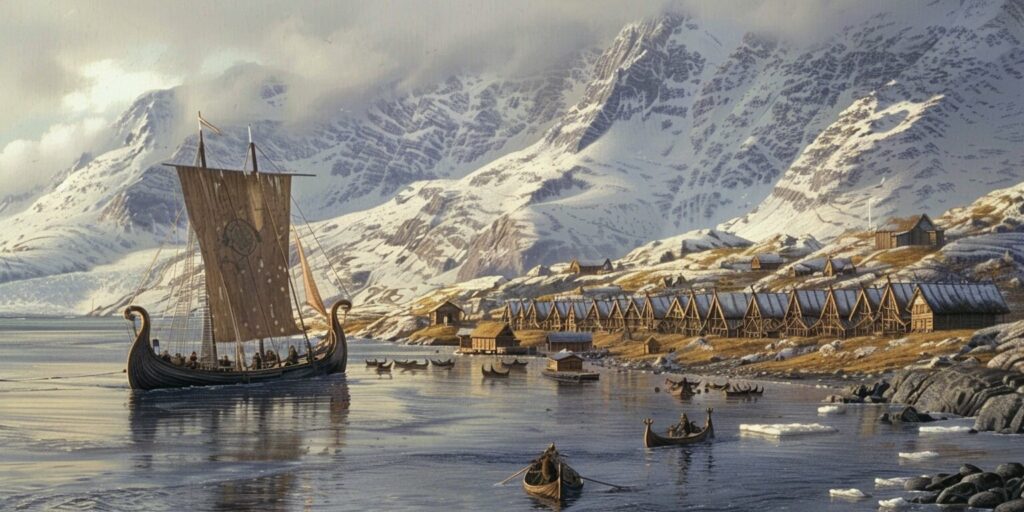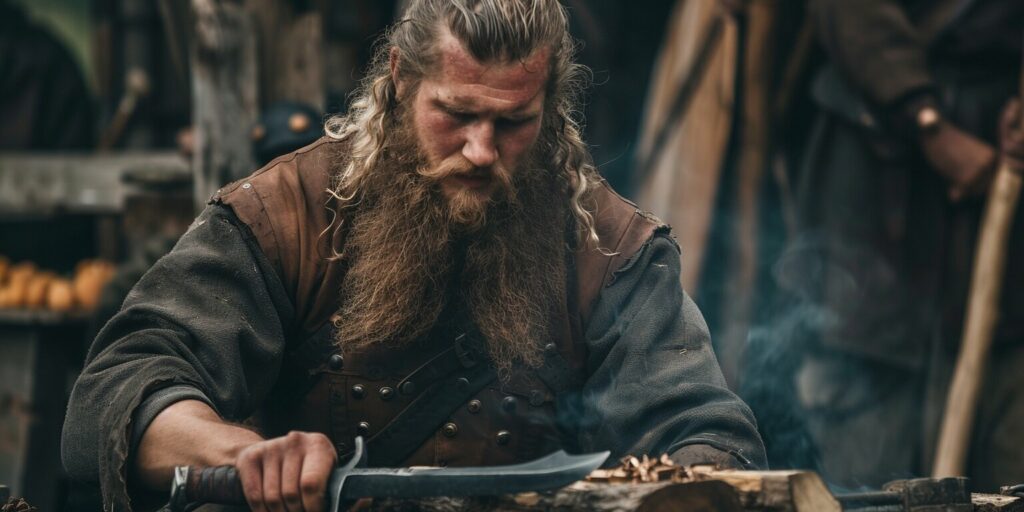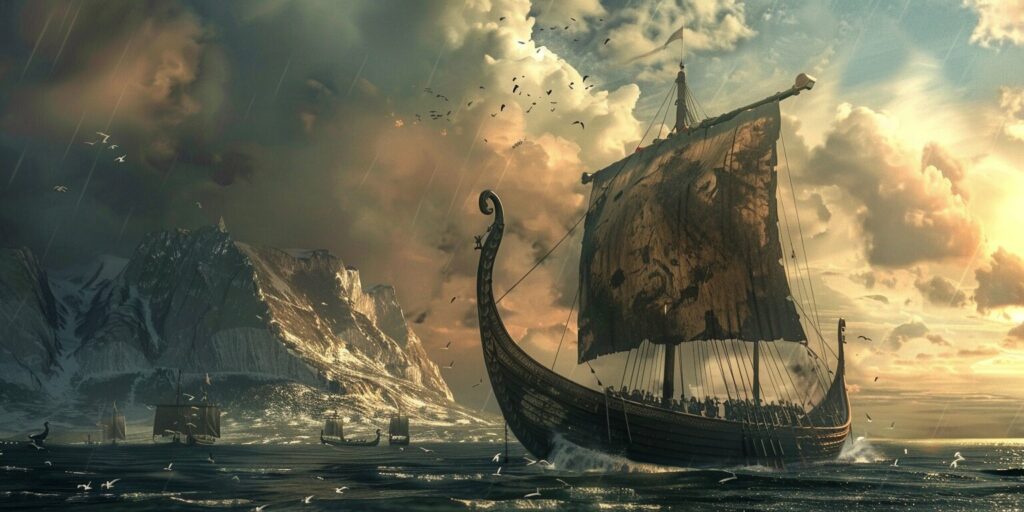Daily Life in the Viking Age, Tales of the Gods, Viking Heritage, Vikings
Time Travelers’ Guide: Navigating the Viking Age from Start to Finish
Welcome to our comprehensive guide to the Viking Age timeline. In this journey through history, we will explore the remarkable era of the Vikings, answering the common question of when did the Vikings era start and end. Join us as we uncover the key events and significant milestones that shaped the Viking Age.
Delve into the origins of the Viking Age and discover when this extraordinary era began. We will explore the factors that contributed to the rise of the Norse seafarers, explorers, and warriors. From the first raids and expeditions, we will trace the growth of the Vikings’ historical timeline. As our journey through time comes to a close, reflect on the lasting impact of the Viking Age. Marvel at the achievements, contributions, and legacy of the Vikings, whose influence can still be felt today.
Origins of the Viking Age
Embark on a journey into the beginnings of the Viking Age, a remarkable era that left an indelible mark on history. Explore the factors that led to the rise of the Norse seafarers, explorers, and fierce warriors.
The Viking Age, often referred to as the Viking period, is believed to have started around the late 8th century and continued until the late 11th century. However, pinpointing the exact year when the era began can be challenging due to the absence of written documentation from that time.
But why did the Vikings emerge and set sail across distant seas?
The Viking Age was, in many ways, a product of its time. Various factors played a role in the Vikings’ expansion and exploration. Economic pressures, population growth, and a desire for wealth and adventure were some of the catalysts that fueled their ambitions.
As seafaring experts, the Norse were well-acquainted with navigating treacherous waters and taking advantage of favorable winds and currents. Their exceptional shipbuilding skills enabled them to travel further and faster than other civilizations of the time.
The early raids and expeditions set the stage for the Viking Age. These acts of piracy and exploration, often targeting monasteries and wealthy coastal settlements, were the first signs of the Viking presence. As their prowess and reputation grew, so did their influence in the regions surrounding the North and Baltic Seas.
Understanding the origins of the Viking Age can provide valuable insights into this remarkable civilization and its impact on the world. In the following sections, we will delve deeper into the Viking Age timeline and explore its expansion, society, culture, warfare, and lasting legacy.
Expansion and Exploration
Embark on a chronological journey through the Viking Age timeline as we uncover Viking communities’ remarkable expansion and exploration. From their early ventures to the British Isles to their legendary voyages to Iceland and Greenland, the Vikings were driven by an insatiable thirst for new lands and opportunities.
In the late 8th century, the Vikings set their sights on the British Isles, launching raids that ignited fear and uncertainty among the local populations. These daring attacks paved the way for significant Viking settlements in regions such as York and Dublin. The Vikings’ presence in these areas left an indelible mark on the cultural and linguistic landscape.
Expanding their horizons further, Viking explorers ventured westward, braving treacherous seas to discover new territories. In the 9th century, the legendary Norse explorer Erik the Red led an expedition to establish the first Norse settlement in Greenland, while other fearless seafarers ventured even further, reaching the shores of North America centuries before Christopher Columbus.

However, the discovery and colonization of Iceland truly showcased the Vikings’ tenacity and adaptability. In the late 9th century, Viking settlers established thriving communities on this remote island, discovering fertile land and abundant natural resources. Despite the harsh conditions, the Vikings flourished, building a prosperous society in their newfound homeland.
Pioneers of the North Atlantic
As time went on, the Viking voyages continued, expanding their reach across the North Atlantic. Their mastery of navigation led them to explore the Faroe Islands, further solidifying their presence in the North Atlantic region. Using impressive seafaring skills, Viking ships powered by wind and oar allowed them to traverse vast distances, reaching previously uncharted lands.
The Viking expeditions to the Faroe Islands and beyond opened up new trade routes, enabling the exchange of goods, ideas, and culture. The Vikings’ thirst for exploration fueled their desire for wealth and power and allowed for interactions with different civilizations, leading to the merging of cultures and the dissemination of Norse influence across the globe.
The Legacy of Viking Exploration
The Viking Age timeline bears witness to the audacious spirit of these intrepid explorers. Their expeditions and settlements shaped the course of history, leaving lasting legacies in the lands they discovered. The Vikings ‘ impact on these regions was profound, from establishing Norse colonies in Greenland and Vinland (North America) to forming the Greenlandic Norse sagas.
The Vikings’ historical timeline reveals a period marked by the Vikings’ unwavering spirit of exploration and relentless pursuit of new frontiers. Their voyages forever changed our understanding of the world, connecting distant lands and cultures and cementing their place in history.
Viking Society and Culture
Delve into the vibrant society and captivating culture of the Vikings during the Viking Age timeline. Gain a deeper understanding of their social structure, religious beliefs, and daily way of life that contributed to their enduring legacy.
Social Structure
The Vikings had a hierarchical social structure, with the jarls (nobles) at the top, followed by the Karls (free farmers), and then the thralls (slaves). The jarls, known for their wealth and power, controlled large estates and commanded the loyalty of their warriors.
Farming played a significant role in Viking life, as society depended on agriculture. Most free Vikings were farmers who owned their land and were responsible for cultivating crops and raising livestock.
Religious Beliefs
The Vikings worshipped a pantheon of gods and goddesses, with Odin, Thor, and Freyja being among the most well-known. They believed in a rich mythology filled with tales of heroic deeds, creation, and the apocalyptic battle of Ragnarok.
While we mostly associate the Vikings with their fearsome reputation as warriors, their daily life was also deeply intertwined with religion. They offered sacrifices and held religious festivals to honor their gods and seek protection and prosperity.
Craftsmanship and Shipbuilding
The Vikings were renowned for their exceptional craftsmanship and intricate designs. Their mastery extended to various mediums, including metalwork, jewelry, woodworking, and textiles. Their artwork’s intricate patterns and symbolism showcased their creativity and artistic skills.

One of the most significant achievements of Viking culture was their advanced shipbuilding techniques. They constructed longships, sleek, swift vessels capable of navigating shallow rivers and rough seas. These ships were instrumental in their exploration, trade, and warfare.
Trading Networks
The Vikings were skilled traders and established a vast network that stretched across Europe, Asia, and even Africa during the Viking Age timeline. They engaged in long-distance trade, exchanging goods such as furs, amber, iron, slaves, and luxury items like silver and silk.
The Vikings acquired valuable resources and wealth through their trading expeditions and spread their cultural influence across distant lands. They left a lasting impact on the regions they visited, forging connections and leaving behind cultural, linguistic, and genetic imprints.
Viking Warfare and Conquests
Step back in time and uncover the legendary reputation of Viking warriors during the Viking Age. These fierce Norsemen were driven by their thirst for conquest, and their military prowess carved a path through history. Let’s delve into the strategies, battles, and victories that defined the Viking Age timeline.
1. Military Strategies
The Vikings were strategic in their approach to warfare, utilizing their knowledge of the land and sea to their advantage. Viking raiding parties were swift and unpredictable, launching surprise attacks on unsuspecting coastal settlements. Their speed and agility gave them an edge over their opponents, allowing them to strike fear into the hearts of their enemies.
2. Legendary Battles
The Viking Age witnessed numerous legendary battles that showcased the ferocity and skill of Viking warriors. One such battle was the Battle of Stamford Bridge in 1066, where the Viking king Harald Hardrada and his army faced off against the English forces under King Harold II. The battle was intense and brutal, resulting in a hard-fought victory for the English. This battle marked the end of Viking attempts to conquer England.
3. Notable Victories
The Vikings achieved several notable victories throughout their conquests. One significant victory was their capture of York, then known as Jorvik, in 866. This allowed the Vikings to establish a stronghold and exert control over the region. Another remarkable triumph came in 911 when the Viking leader Rollo negotiated the Treaty of Saint-Clair-sur-Epte with the French king Charles the Simple, securing control of the territory that would become Normandy.
4. Impact on European Kingdoms
The Viking invasions had a profound impact on European kingdoms. Their raids and conquests disrupted the stability of established societies, causing fear and unrest. European monarchs had to fortify their cities and coastlines to defend against Viking attacks, which led to the development of stronger defenses and naval forces. The Vikings’ presence and influence also left lasting cultural, linguistic, and genetic legacies across the territories they conquered.
As we reflect on the Viking period timeline, we cannot overlook the formidable reputation of Viking warriors and their lasting impact on history. Their military strategies, legendary battles, and notable victories shaped the course of Europe and left an indelible mark on the world.
Final Words
As we come to the end of our time travel journey through the Viking Age timeline, we can’t help but marvel at the Vikings’ incredible achievements, contributions, and lasting legacy. This extraordinary era, which spanned from the late 8th century to the 11th century, profoundly shaped history.
The Vikings, known for their remarkable seafaring skills and fierce warrior spirit, left an indelible mark on the world. Through their exploration and expansion, they established settlements across Europe and beyond and forged new trade routes that connected distant lands.
But the Viking Age was not just about conquest and exploration. It was a time of cultural exchange as the Vikings assimilated and adapted to the societies they encountered. The Vikings’ rich society and culture, with their unique social structure, religious beliefs, and advanced craftsmanship, continue to captivate and inspire us today.
The Vikings ‘ legacy lives on, from their legendary sagas and epic battles to their enduring influence on art, language, and even modern-day Viking festivals. So, as we bid farewell to this captivating chapter in history, let us continue to explore, learn, and appreciate the profound impact of the Viking period timeline.

